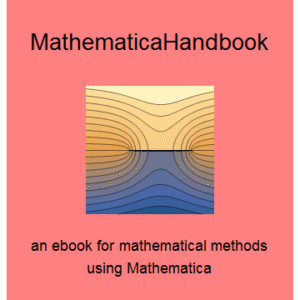Product Detail
The MathematicaHandbook™ is an ebook that consists of Mathematica notebooks that are accessed through a Mathematica palette, so Mathematica (not just Mathematica Player) needs to be installed on your machine to be able to read it. The palette window will open every time Mathematica is launched, so it will always be accessible as a reference guide when you are working in Mathematica.
MathematicaHandbook consists of approximately 90Mb of content which is downloaded using the installer, which can be found here. The Handbook is compatible with Mathematica 10 and 11 and can be installed on either PCs ( Windows 7-10) or Macs (OS X).
Navigation through the MathematicaHandbook is facilitated by the buttons and pull-down menus in the navigation palette, as well as an extensive table of contents and index with hyperlinks. The Handbook is convenient for quick reference because each notebook has a short introductory text followed by an outline which has hyperlinks to the various topics covered in the notebook. In contrast to a dead tree or Kindle book, the MathematicaHandbook is a dynamic document, so functions, interactive graphics and extensive code can be executed within the browser or copied and pasted into your own notebook.
In addition to the Mathematica Usage Tutorial, (described here), the MathematicaHandbook™ contains discussions of mathematical topics found in traditional mathematical methods textbooks. Both the mathematical theory as well as the implementation in Mathematica are illustrated with examples which make frequent use of graphics and animations, which makes it more pedagogically effective than a conventional dead tree book. A description of the contents of the Handbook and how it works within Mathematica is shown in this video.
Topics covered include:
- Lagrange multipliers and constrained optimization
- Calculus of variations
- Dimensional analysis
- Ordinary differential equations
- Fourier series and transforms
- Perturbation theory
- Probability and statistics
The section on Applications and Case Studies applies computer methods covered earlier to more advanced problems in physics and engineering. Some of the topics are:
- Circuits
- Fluid Mechanics
- Thermodynamic derivatives
- Digital sampling
- Molecular dynamics simulations
- 1D quantum well
- Wave guides
The complete Table of Contents of the MathematicaHandbook can be seen here.
The complete Index can be seen here.
Showing the single result

